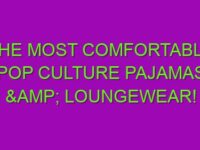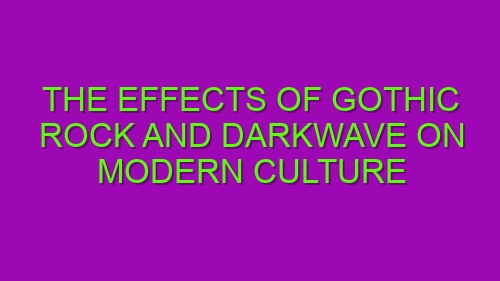-
Table of Contents
The Influence of Gothic Rock and Darkwave on Fashion Trends
Gothic rock and darkwave music have had a profound influence on modern culture, extending beyond the realm of music and into various aspects of society. One area where their impact is particularly evident is in the world of fashion. The unique aesthetic and mood of these genres have inspired and shaped fashion trends, creating a distinct style that continues to captivate individuals today.
Gothic rock emerged in the late 1970s as a subgenre of punk rock, characterized by its dark and brooding sound. Darkwave, on the other hand, developed in the 1980s as a fusion of gothic rock and electronic music, incorporating haunting melodies and introspective lyrics. Both genres share a common theme of melancholy and introspection, which is reflected in the fashion choices of their followers.
One of the most notable influences of gothic rock and darkwave on fashion is the prevalence of black clothing. Black has become synonymous with these genres, symbolizing the darkness and mystery that they embody. The all-black attire, often accompanied by leather, lace, and fishnet fabrics, creates a striking and edgy look that has become a staple in gothic and darkwave fashion.
Another significant aspect of gothic rock and darkwave fashion is the emphasis on individuality and self-expression. These genres have fostered a sense of nonconformity, encouraging individuals to embrace their unique style and reject societal norms. As a result, gothic and darkwave fashion often incorporates unconventional elements such as extravagant makeup, elaborate hairstyles, and accessories like chokers, spikes, and chains. These elements allow individuals to express their creativity and showcase their personal identity.
The influence of gothic rock and darkwave on fashion extends beyond individual style choices and has also permeated the world of high fashion. Designers have drawn inspiration from the dark and moody aesthetic of these genres, incorporating elements such as black lace, corsets, and Victorian-inspired silhouettes into their collections. This fusion of gothic and high fashion has resulted in a unique and captivating style that has been embraced by fashion enthusiasts worldwide.
Furthermore, gothic rock and darkwave fashion have also influenced the alternative fashion scene, giving rise to subcultures such as goth, emo, and steampunk. These subcultures have adopted and adapted the gothic and darkwave aesthetic, creating their own distinct styles. Goth fashion, for example, often features a more dramatic and theatrical look, with an emphasis on dark makeup, extravagant hairstyles, and Victorian-inspired clothing. Emo fashion, on the other hand, incorporates elements of gothic fashion with a more casual and youthful twist, often characterized by band t-shirts, skinny jeans, and dyed hair. Steampunk fashion combines elements of gothic and Victorian fashion with a futuristic twist, resulting in a unique blend of vintage and industrial aesthetics.
In conclusion, the influence of gothic rock and darkwave on fashion trends is undeniable. These genres have inspired a distinct style characterized by black clothing, unconventional accessories, and an emphasis on individuality and self-expression. From the streets to the runways, the impact of gothic rock and darkwave on fashion continues to be felt, creating a lasting legacy that has shaped modern culture.
Exploring the Impact of Gothic Rock and Darkwave on Music Genres
Gothic rock and darkwave are two music genres that have had a significant impact on modern culture. Both genres emerged in the late 1970s and early 1980s, and their unique sound and aesthetic have influenced a wide range of artists and subcultures.
Gothic rock, also known as goth rock, originated in the United Kingdom with bands like Bauhaus, Siouxsie and the Banshees, and The Cure. It is characterized by its dark and atmospheric sound, often featuring haunting vocals, melodic guitar riffs, and introspective lyrics. Gothic rock draws inspiration from various sources, including post-punk, glam rock, and even classical music. Its melancholic and introspective nature resonated with a generation of disenchanted youth, who found solace in its brooding and introspective themes.
Darkwave, on the other hand, emerged as a subgenre of gothic rock in the 1980s. It is characterized by its ethereal and atmospheric sound, often incorporating synthesizers, drum machines, and electronic elements. Darkwave artists like Clan of Xymox, Cocteau Twins, and Dead Can Dance created a dreamlike and otherworldly atmosphere with their music. Darkwave’s introspective and introspective lyrics often explore themes of love, loss, and existentialism, creating a sense of emotional depth and introspection.
The impact of gothic rock and darkwave on modern music genres cannot be overstated. These genres have influenced a wide range of artists across different musical styles. Many alternative rock bands, such as The Smashing Pumpkins, Nine Inch Nails, and Marilyn Manson, have incorporated elements of gothic rock and darkwave into their music. The atmospheric and introspective nature of these genres has also influenced the development of genres like post-punk revival, shoegaze, and even electronic music.
Beyond the realm of music, gothic rock and darkwave have also had a profound impact on fashion and subcultures. The goth subculture, characterized by its dark and macabre aesthetic, emerged as a result of the influence of gothic rock. Goths often dress in black clothing, wear heavy makeup, and embrace a sense of individuality and non-conformity. Gothic fashion has become an important part of alternative culture, with its influence extending to mainstream fashion and popular culture.
Moreover, gothic rock and darkwave have also influenced visual arts, literature, and film. The dark and atmospheric nature of these genres has inspired artists and writers to explore themes of darkness, mystery, and the supernatural. Gothic literature, with its emphasis on horror, romance, and the macabre, owes much to the influence of gothic rock and darkwave. Films like “The Crow” and “Only Lovers Left Alive” have also drawn inspiration from these genres, creating a visual and narrative aesthetic that reflects their brooding and introspective nature.
In conclusion, gothic rock and darkwave have had a profound impact on modern culture. Their unique sound and aesthetic have influenced a wide range of artists and subcultures, shaping the development of music genres, fashion, visual arts, literature, and film. The atmospheric and introspective nature of these genres continues to resonate with audiences, providing a sense of emotional depth and introspection that transcends time and trends. As long as there are individuals who find solace in darkness and introspection, the influence of gothic rock and darkwave will continue to be felt in our culture.
Analyzing the Role of Gothic Rock and Darkwave in Contemporary Art and Literature
Gothic rock and darkwave are two music genres that have had a significant impact on modern culture. Both genres emerged in the late 1970s and early 1980s, and their influence can be seen in various forms of contemporary art and literature. This article aims to analyze the role of gothic rock and darkwave in shaping modern culture.
One of the most notable effects of gothic rock and darkwave on modern culture is their influence on visual arts. The dark and melancholic themes present in these genres have inspired many artists to create works that reflect the same mood. Paintings, sculptures, and installations often incorporate elements of gothic rock and darkwave, creating a sense of mystery and introspection. The use of dark colors, eerie imagery, and haunting atmospheres are all characteristic of this artistic movement.
Literature is another area where gothic rock and darkwave have left their mark. Many contemporary authors draw inspiration from the themes and aesthetics of these genres, resulting in a resurgence of gothic literature. The exploration of the human psyche, the supernatural, and the macabre are common elements found in gothic novels and short stories. The influence of gothic rock and darkwave can be seen in the works of authors such as Neil Gaiman, Poppy Z. Brite, and Caitlín R. Kiernan.
Film and television have also been greatly influenced by gothic rock and darkwave. The atmospheric and moody nature of these genres has found its way into many movies and TV shows. Directors and producers often use the music and visual aesthetics of gothic rock and darkwave to create a sense of unease and suspense. The influence of these genres can be seen in films like “The Crow,” “Only Lovers Left Alive,” and TV shows like “Penny Dreadful” and “American Horror Story.”
Fashion is another area where gothic rock and darkwave have made a significant impact. The dark and edgy style associated with these genres has become a popular fashion trend. Many people embrace the gothic aesthetic, wearing black clothing, leather, and accessories adorned with spikes and studs. The influence of gothic rock and darkwave can be seen in the fashion industry, with designers incorporating elements of these genres into their collections.
Furthermore, gothic rock and darkwave have also influenced the way people express themselves and connect with others. The music and lyrics of these genres often explore themes of alienation, introspection, and the darker aspects of human existence. Many individuals find solace and a sense of belonging in the gothic subculture, using it as a means of self-expression and identity formation. Gothic rock and darkwave have created a community where like-minded individuals can come together and share their love for these genres.
In conclusion, gothic rock and darkwave have had a profound impact on modern culture. Their influence can be seen in various forms of contemporary art and literature, as well as in film, fashion, and personal expression. The dark and melancholic themes present in these genres have resonated with many individuals, creating a sense of connection and belonging. Gothic rock and darkwave continue to shape modern culture, leaving an indelible mark on society.



















